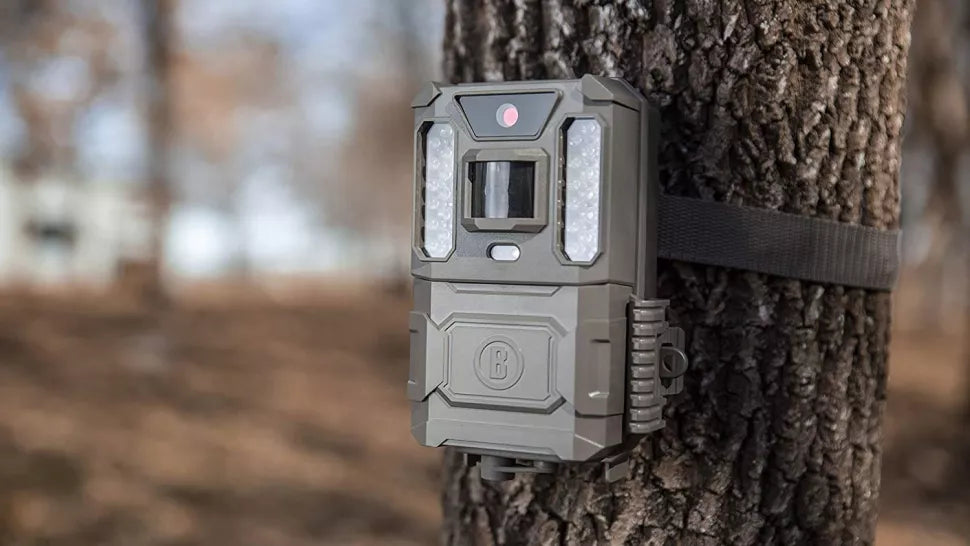The best trail cameras can enable you to take photos of wildlife that would be near-impossible with an ordinary camera. Even with a powerful telephoto lens, all the necessary accessories and infinite patience, you're far from guaranteed to get that perfect wildlife shot, but with a well-placed trail camera you can easily capture stunning photos and videos of even the most reclusive creatures. So what's the secret?
Simply, trail cameras are designed to be set up outdoors and then left for a long time to do their thing. While many wild animals are sensibly neophobic and will stay away from new stuff in their territories, eventually they'll become acclimatised to the trail camera and carry on as normal around it. Trail cameras are fitted with infrared motion sensors that'll detect when an animal comes within range, and capture still images or video (or both) of whatever's in its field of view. Trigger times can be as fast as a fifth of a second, so a good trail camera can give you the opportunity to capture wildlife behaviour that you'd never get to witness in person.
So as not to spook the wildlife, the best trail cameras are usually well-camouflaged and silent in operation. Most are equipped with night vision as well as no-glow infrared flashes, which can illuminate a scene without animals even realising. And top-end models can even connect to cellular or mobile networks, making it easier for you to get images and videos from them without having to go near the camera.
Setting up a trail camera effectively can involve a bit of trial and error; it's very easy to think you've positioned it perfectly, then find you've captured nothing but empty scenes and the occasional tip of a tail vanishing out of frame. So to help you out, we've provided some tips on how to prep your trail camera to deliver incredible wildlife imagery; scroll to the bottom of this article to get clued up.
We've gathered together a selection of the best trail cameras at a range of prices. Bear in mind, though, that on top of the purchase price you're going to need to spend a fair bit of money on batteries, especially if you're planning to leave your camera in place for weeks on end.
And on top of that you'll also need a well-sized memory card for all the images and videos captured by your trail camera; our guide to the best memory cards will help there. If you want a more conventional wildlife setup, then try our guides to the best cameras for wildlife photography and best cameras overall may prove helpful.
The best trail cameras available now

This trail camera is actually two in one, as the Bushnell Core DS No Glow is equipped with two sensor. One is optimised for daytime, and is a balanced all-rounder that produces clear images when there's lots of light available. The other is a night sensor, and has been tailored to provide additional illumination in darker conditions, aided by no-glow LED lighting.
This versatility makes the Bushnell Core DS No Glow trail camera our top pick for wildlife-spotting, though it's also got other assets going for it, such as its 30MP stills resolution. A notch higher than a lot of other trail cameras, this gives the Bushnell Core DS No Glow trail camera yet more flexibility, allowing you to crop into an image more easily to get a better view of a subject that didn't get as close to the camera as you might have preferred.
With Full HD 60p video, the camera is no slouch when it comes to video either, and its trigger time of 0.2 seconds is top-notch. It doesn't have cellular capability like some other trail cameras on this list, though with the monthly costs involved, this isn't something everyone wants anyway. You'll just have to venture back out into the wild to see what this excellent camera has captured.
- Also see: The best low-light cameras in 2022

This budget offering from Bushnell is ideal for those who need a trail camera at an affordable price point. The Bushnell Prime Low Glow Trail Camera still offers Full HD video at a 60p frame rate, meaning your footage will be smooth and high-quality, while its stills resolution of 24MP is respectable enough that you'll get images with plenty of detail.
The Bushnell Prime Low Glow Trail Camera also has 80-foot flash lighting, enabling it to capture subjects in the dark. It also requires only six AA batteries, which is quite a few less than plenty of other trail cameras, and makes powering the camera less of a hassle. If you're on a budget, this is an excellent choice of trail camera.

A 4K trail camera isn't something you see everyday. The Spypoint Force Pro trail camera immediately outstrips a lot of its competition in raw pixels terms. However, we'd be cautious about recommending it on the strength of 4K alone, as it shoots at this resolution at an extremely choppy frame rate of 10fps. This is less than ideal, to say the least.
Fortunately though, the Force Pro trail camera also shoots at 2560x1440, which is still a higher resolution than most other trail cameras can manage, and it does so at a much more agreeable frame rate of 25fps. Elsewhere, the other features of the camera also impress, with a 0.2sec trigger time, and on-board audio recording. With 54 white no-glow LEDs emitting infrared light at 950nm, the Spypoint Force Pro trail camera can light up pretty much any subject that wanders past, without alerting it. If your budget goes this far, it's a fantastic choice.

This trail camera offers superb value for money which means it's competing with some of the more expensive models that would otherwise be out of its class. It captures Full HD video and shoots 10MP still images, and can react to subject movement faster than 0.5 seconds. It has a lengthy video record time of up to 180 seconds and can trigger up to nine still images when in burst mode.
The Stealth Cam G42NG can sit out in all weathers and even take a beating due to its waterproofing and durable construction. Running on just eight AA batteries it will cost less to maintain and power compared with competition that runs on far more. Files include metadata such as time, date, moon phase and temperature to help better inform the photographer/hunter, giving better accuracy when studying the subject.

A real set-it-and-forget-it type of trail camera, the Spypoint Solar Dark is a device that can be left for long periods because of its own green energy modules. This trail cam is powered by a Lithium-ion battery which is rechargeable, fed by a solar panel on the top of the device. It'll even keep running when the sun's gone behind cloud because it has a second charging option in the form of six AA batteries.
It has a lightning fast trigger speed of 0.07 seconds for speedy wildlife and is studded with 42 super-low-glow LEDs to light subjects in the dark or at night. It can record video for up to 1.5 minutes but only at 720P resolution, this is still detailed enough for most users though. It also offers 12MP stills capture which isn't the best in this round-up but at this price it doesn't pretend to be either.
One thing to note is that the Spypoint Solar Dark has been going in and out of stock recently, especially in the US. If you like the look of it and see it's available, it could be worth snapping it up sooner rather than later.

This tiny trail camera is only five inches in height. Ultra-compact and lightweight, the Spypoint Force-20 Trail Camera boasts some excellent features for its size and price. Though video resolution tops out at 720P it can trigger quickly at 0.7 seconds and captures impressively detailed 20MP stills photographs. It'll light up the foreground at up to 80 feet and can work in temperatures between -30 °C and +50 °C performing well in almost any climate imaginable.
The Force-20 is perfect for photographers or hunters that require something small and compact but at an affordable price, but it should be noted that there is no audio recording to accompany video options.

As you can probably tell by now Spypoint offer a great range of trail cameras. While some are more complex, the Link-Micro-LTE is a no frills cam. Taking its heritage from the previous model it boosts features with the inclusion of a reliable LTE cellular link-up for remote viewing. It should be noted though, that although it's relatively inexpensive it also doesn't shoot video. That means it doesn't have good capacity for tracking subjects' movements in a scene. However, what it doesn't have in moving image capability it more than makes up for in convenience thanks to its cellular connectivity.
Using the Spypoint App owners can manage all camera setting, and use intelligent scouting tools such as the enhanced AI species filters, weather, and mapping integration to refine the tracking process. A quick 0.5 second trigger isn't to be sniffed at for this low price point, either.

The Browning Defender is a superb all-purpose trail camera. It offers loads of great features and functions. Video resolution is Full HD, stills resolution is a generous 20MP, and the LTE 4G cellular link-up allows for remote viewing and download of your images.
We could go on about this trail camera's excellent features... and we will. The full waterproofing means you can leave it in the wet and wild outdoors with confidence, and the low-glow infrared flash opens up the night and allows you to capture subjects that only make an appearance at night. The camera has a card slot that supports SDXC cards with capacities of up to 512GB – more than enough storage for pretty much any user. There's also the Invisible IR mode, which basically makes it completely undetectable, and is great for scoping out the most shy and retiring of subjects.
The Browning Defender requires a hefty sack of 16 AA batteries to work. This may sound like a lot (because it is) but as we'll see, this isn't exactly uncommon for trail cameras. This will at least keep the Browning Defender running for a good long while – and if you invest in some rechargeable batteries up front, you'll probably save some cash in the long run. Be aware that it's harder to get outside of the US, so those in other territories may want to consider a different option.

The Bushnell CelluCore 30 is a relatively recent refresh of a popular trail camera, the CelluCore 20. And this name isn't just a number – it also denotes the fact that the camera's megapixel count has been upped from 20MP to 30MP. This makes it the highest-resolution trail camera around right now, and an ideal choice if you're looking to capture images with plenty of detail.
It's well-specced elsewhere too, with a 100-foot no-glow infrared flash for night vision, and the ability to capture high-quality 1080p video at a silky-smooth frame rate of 60p. The trigger speed is a quick 0.2 seconds, so it should be able to capture even the most fleeting of wildlife behaviours. The name CelluCore comes from the fact that it's cell-network enabled, so you can transfer images and videos remotely using a Verizon or AT&T data plan. This does mean that it's currently harder to get and use if you're outside the US – though having a 32GB SD card slot is helpful as it means you can just store images locally. Just be aware before you buy that you'll need 12 AA batteries to power it, which is fewer than the Browning Defender, but still quite a lot.
This is another option that's still spottily available outside the US – readers in the UK may want to try the Bushnell CelluCore 20(opens in new tab) instead.
How do I choose the best trail camera?
Far from basic point-and-shoot cameras (though there are certainly models that do just this) the more reputable trail camera manufacturers offer devices that come in all shapes and sizes. Making a conscious decision about which features you'll need and others you can live without will stand users in good stead for purchasing the right device. Still image and video resolution (including video frame rate) is important, but so too is cellular connectivity so that you can view or record from remote locations. Good night sight or a dedicated night-time image sensor is essential for capturing subjects in the dark, but some cameras come with an undetectable infrared option, too.
If visiting the location is difficult or likely to disturb shy subjects then solar panels can help prevent the need for battery changes, as they sport rechargeable lithium ions. Strong camouflage or plain earth tones also help trail cameras go undetected by wildlife subjects and security threats if using the camera for this purpose.
Composition can be tricky when setting up a wildlife camera, so if that's important then consider a unit with an LCD built-in so that you can line-up the device before leaving the area. Weather sealing and a durable construction are also important, as are operation temperature ranges if you're planning on using it somewhere extreme.
How to prepare a trail camera
First, you'll need to scent-proof the camera by washing it with water or a field wipe. Some sources suggest leaving it outside for a week before use to completely eliminate odour to ensure it isn't off-putting to wildlife.
Cheap batteries could leave you disappointed as they may not last, so invest in good quality ones. Some trail cameras have their own rechargeable battery; if yours does, make sure it's well charged the night before you plan to use it. Other trail cameras use simple batteries like AA or AAA; if so, make sure you have plenty to hand, ideally rechargeable ones to cut down on waste.
Finally, research which camera mode you want to use. Outdoor Life(opens in new tab) recommends a "three picture burst with a 15-second delay" as it allows for more chance of getting the perfect shot.
Where to install your trail camera
Choose a place that attracts wildlife, be that a field, a wooded area or similar depending on what kind of animal you want to photograph. You want to find somewhere animals feel secure enough to congregate, like corners, water or field edges.
Assess animal behaviour when making your choice, food and water sources are reliable as are the corridors leading up to them. Having multiple cameras set up could help you find the best place, so don't be afraid to experiment.
How to mount your trail camera
First, you may need to buy a mount. The brand that makes your camera may have its own option, or there are many others (see a selection of mounts here(opens in new tab)).
Mount your camera on something rigid – a fence, post, tree or metal stake work well since they won't move around if disturbed. Make sure there are no stray bits of vegetation that could set off your camera unnecessarily by waving around. Finally, be aware of where the sun is rising/setting to avoid a washed out picture.
Are trail cameras good for home security?
Absolutely – everything that makes a trail camera great for spotting a reclusive deer can also make it highly suitable for home security. The fact that trail cameras are designed to be left outdoors means you can mount one outside your home, and rely on the motion trigger to let you know when someone (or something) enters the camera's field of view.
If you're looking to use a trail camera for home security, then we'd say get one with at least HD resolution so you can clearly see what's happening. You also might want to consider getting a camera with cellular capability, so that you can get an instant alert on your phone when the camera detects movement.










